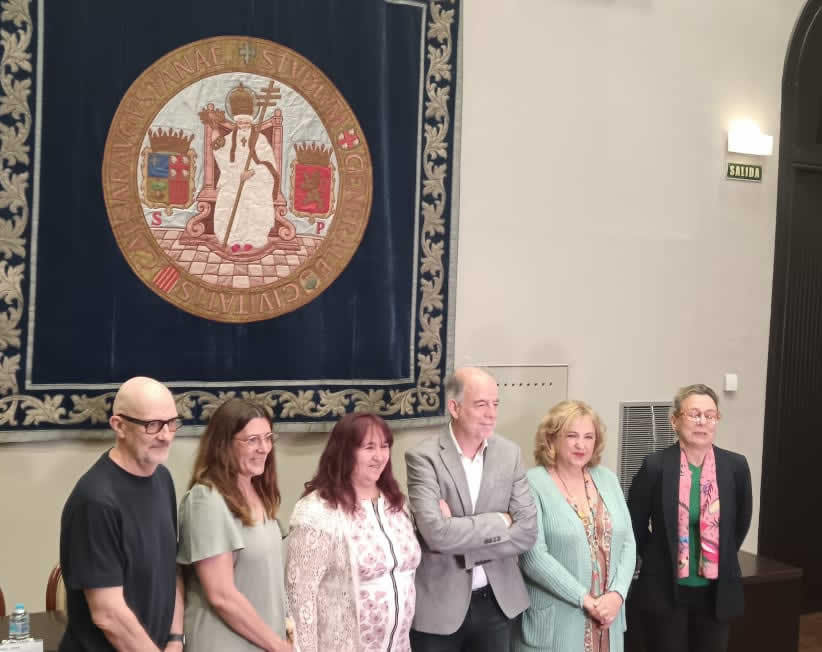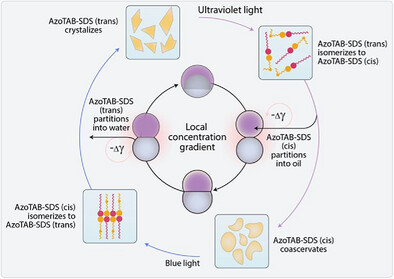Professor Jesús Santamaría wins his third Advanced Grant, the most prestigious European support for excellence in research.
Only five other researchers in Spain have won three of these competitive grants, awarded by the European Research Council.
With more funding than usual, €3.1 million, the scientist from the University of Zaragoza at INMA, a joint CSIC-Unizar centre, and IIS Aragón, will spend five years researching how to target nanoparticles with drugs more effectively at tumours.
The ERC Advanced Grant ROMEO is one of the 281 selected, only 14 Spanish, among the 2,534 proposals submitted to the call of the Horizon Europe programme for scientific leaders of proven excellence.
(Zaragoza, Monday 23 June 2025). This innovative proposal in nanomedicine focuses on directing therapeutic particles more effectively towards the tumour and will be carried out over the next five years from the Aragonese capital. It has been obtained by Jesús Santamaría, professor of Chemical Engineering at the University of Zaragoza, and member of the Institute of Nanoscience and Materials of Aragon (INMA), a joint CSIC-Unizar centre, and the Institute for Health Research of Aragon (IIS Aragon), and is his third Advanced Grant, the most prestigious European backing for excellence in research.
In fact, with the ERC Advanced Grant ROMEO, Santamaría is on the podium of research in Spain, along with five other scientists (Jordi Galí Garreta, Javier Jiménez Sendín, Maciej Lewenstein, Luis Serrano Pubul and Niek Frans Van Hulst), who have obtained their third Advanced Grant, which is exceptional, considering the extreme competitiveness of these projects.
This important financial support obtained by Santamaría, one of the leading European researchers in the area of synthesis and applications of nanomaterials, is part of the 281 exclusive Advanced Grants awarded by the European Research Council of the Horizon Europe programme, with a total amount of 721M€, and which have been selected among the 2,534 proposals submitted in 2024. Of the funded initiatives, 14 are Spanish and of these, 4 are in the areas of Science and Engineering, including ROMEO.
The grant programme finances research work in Europe selected through a highly competitive process based solely on the novelty (‘frontier research’) of the project and the scientific excellence of the researcher, which is why obtaining a grant from the ERC is one of the greatest recognitions at European level to which a researcher can aspire, as the authorities emphasised today in the presentation of this project that took place in the Auditorium. The presentation was attended by the rector of the University of Zaragoza, Rosa Bolea; the delegate of the Consejo Superior Investigaciones Científicas (CSIC) in Aragón, María Jesús Lázaro; the vice-rector of Science Policy of Unizar, M. Pilar Pina; the director of INMA (mixed CSIC-Unizar), M. Elena Gálvez, and the scientific director of the IIS Aragón, Ángel Lanas.
With this new award, the University of Zaragoza has gone from 19 to 20 ERC projects since 2009, with a total amount that rises from €31.7M to €34.8M, distributed among the following categories: Proof of Concept, 3; ERC- Starting,7; ERC-Consolidator, 4; ERC- Advanced, 5 and Synergy Grant, 1.
Of this total funding, Jesús Santamaría has raised in 14 years a total of €7.45M between his three ERC Advanced Grant projects from the European Research Council:
2011: Hector Project, funded with €1.85M to develop a novel reactor with catalysts capable of selective microwave heating.
2017. Cadence project, funded with almost €2.5M, considered the tumour as a catalytic reactor to destroy it from within, generating toxic products in situ. To this end, catalysts capable of being selectively activated were generated.
2025. ROMEO project: Cracking the code on tumour targeting with nanostructures: competitive kinetics and extracellular vesicles. Competitive kinetics and extracellular vesicles), €3.1M.
‘Nanomaterials do not reach the tumour in sufficient quantities’
After more than a century of research efforts, cancer remains a huge health problem, causing almost 10 million deaths each year. This was expected to change with the advent of nanomedicine, following the launch of the first nanoformulation (Doxil) in 1995. However, 30 years later, the promising advances in nanomedicine have failed to translate convincingly into the clinic.
‘The reason is clear,’ says Jesús Santamaría. “It’s not that nanomaterials don’t work, it’s that they don’t reach the tumour in sufficient quantities: on average, less than 1% of nanoparticles administered systemically reach the tumour; in fact, most of them (sometimes up to 95%) end up in the liver, sequestered by the macrophages residing in the sinusoids. Therefore, escaping capture by macrophages and targeting the particles to the tumour becomes the most important issue in cancer nanomedicine.
The strategies of the European ROMEO project
The European ROMEO project has two strategies to achieve this objective: On the one hand, capture kinetics will be evaluated, making different nanoparticles compete to see which are better able to avoid capture by macrophages and which, on the contrary, are preferentially captured. To do this, on the one hand, ‘decoy’ particles will be designed to saturate the macrophages before sending the therapeutic ones. On the other hand, ROMEO will use the group’s experience in extracellular vesicles (EVs) to use them as vectors and achieve more effective targeting of the tumour.
EVs are vesicles emitted by almost every cell in our body, and are essential for intercellular communication. In ROMEO, we will use a very important property of EVs, which is that they are able to preferentially recognise the cell from which they originate. This means that EVs from tumours can be ideal vehicles for delivering therapeutic nanoparticles to tumours. The challenge is to load them with the nanoparticles without disturbing their recognition properties, but the group is currently developing several tools to achieve this.
A budget that exceeds the maximum established
ROMEO has a budget of 3,121,375 euros and an execution period of 5 years. It will be developed in the facilities of INMA and IIS Aragón, by a team composed of five researchers from the University of Zaragoza members of the NFP group (J. Santamaría, V. Sebastián, J.L. Hueso, M. Sancho-Albero and A. Martín Pardillos) and seven more researchers (three postdoctoral, three predoctoral and a technician), who will be hired by the project, among researchers of chemistry, biology and materials profiles. In addition, given the multidisciplinary nature of ROMEO, there will be collaboration with the groups of Dr. Ignacio Ochoa and Diego Gutiérrez, from I3A, and Antonio Monzón, from INMA, as well as with Dr. Ibane Abasolo from IQAC-CSIC, Barcelona.
In this case, the budget exceeds the 2.5 million maximum established for Advanced Grants because the ERC has granted additional budget for the acquisition of scientific equipment, in particular a high-performance confocal microscope.
Jesús Santamaría is one of Europe’s leading researchers in the area of nanomaterials synthesis and applications. His current research topics include the development of new methods for the synthesis of nanomaterials, and applications of synthesised materials in medicine, photoassisted catalysis, microwave catalysis, molecular recognition sensing and nanosafety.
385 published articles, 39 doctoral theses supervised, 26 patents and participation in 101 projects, 20 of them European, including three of the prestigious Advanced Grants of the European Research Council (ERC), endorse Santamaría’s career in the academic and scientific field. Santamaría is the Principal Investigator of the NFP (Nanostructured Films and Particles) research group, and belongs to the Instituto de Nanociencia y Materiales de Aragón (INMA), a joint CSIC-UNIZAR centre, the Instituto de Investigación Sanitaria Aragón (IIS Aragón), and the Centro de Investigación Biomédica en Red de Bioingeniería, Biomateriales y Nanomedicina (CIBER-BBN).
Santamaría ha sido director de la Cátedra Samca de Nanotecnología, y dirige la Cátedra Exobiopharma de Nanomedicina. Ha sido Decano de la Facultad de Ciencias, subdirector del Instituto de Nanociencia de Aragón de Unizar y editor de la revista Chemical Engineering Journal. Ha realizado estancias postdoctorales de investigación en la universidad de Notre Dame y en el Massachusetts Institute of Technology (MIT), ambas en Estados Unidos. Cuenta con numerosos premios y reconocimientos y es miembro del Istituto Lombardo Accademia di Science et Lettere, y de la Academia Europaea, en su división de Ciencias Matemáticas y Naturales, sección de Química. En 2024 fue reconocido con el premio Aragón Investiga a la excelencia “Miguel Servet”. Su pasión por la divulgación le ha acompañado a lo largo de su trayectoria investigadora, con la puesta en marcha de diversas actividades, así como a formar parte del grupo RISArchers, investigadores monologuistas de la Universidad de Zaragoza.
23/06/2025










